Wei Ke
Multi-tracklet Tracking for Generic Targets with Adaptive Detection Clustering
Aug 07, 2025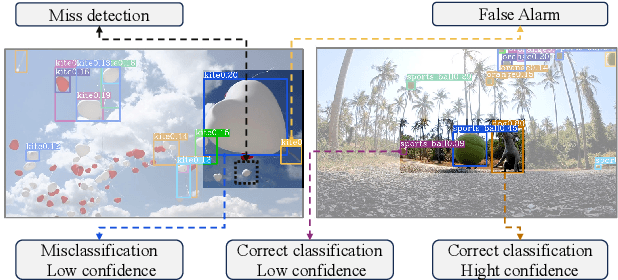
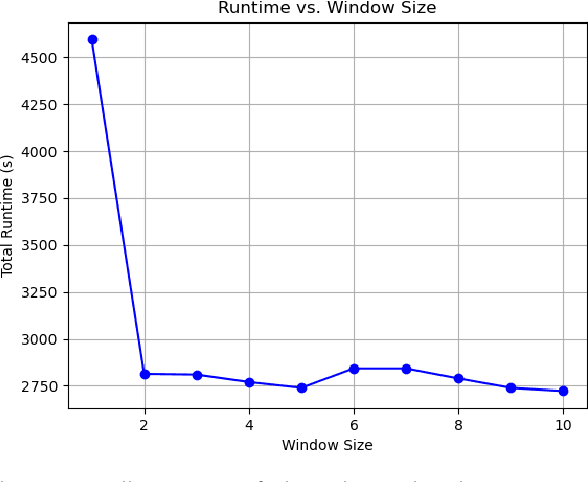
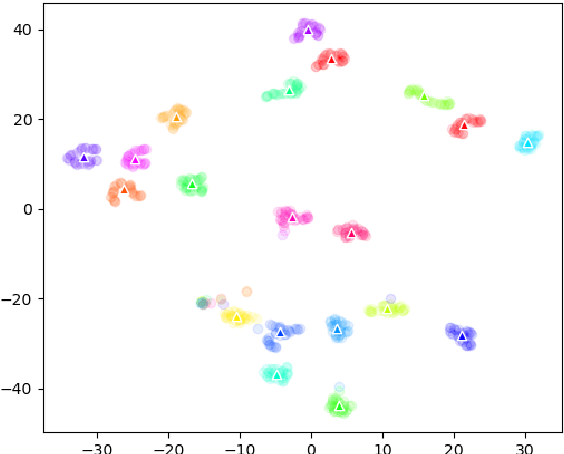
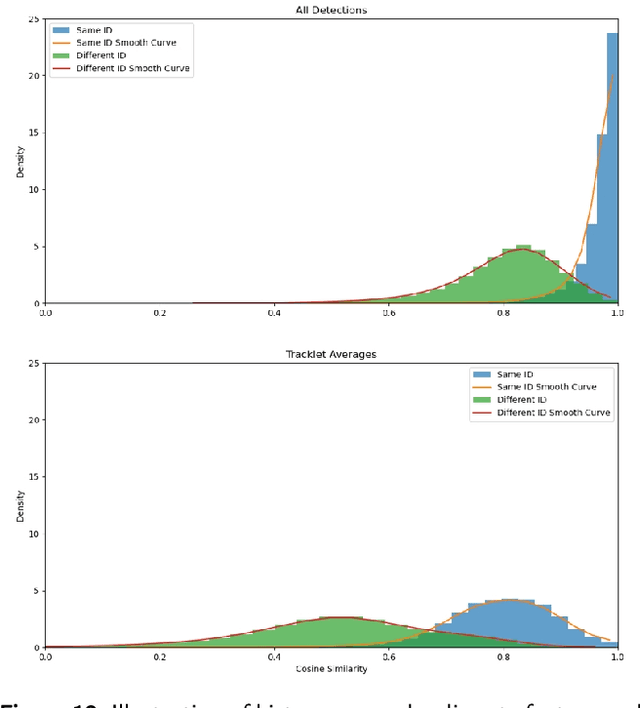
Abstract:Tracking specific targets, such as pedestrians and vehicles, has been the focus of recent vision-based multitarget tracking studies. However, in some real-world scenarios, unseen categories often challenge existing methods due to low-confidence detections, weak motion and appearance constraints, and long-term occlusions. To address these issues, this article proposes a tracklet-enhanced tracker called Multi-Tracklet Tracking (MTT) that integrates flexible tracklet generation into a multi-tracklet association framework. This framework first adaptively clusters the detection results according to their short-term spatio-temporal correlation into robust tracklets and then estimates the best tracklet partitions using multiple clues, such as location and appearance over time to mitigate error propagation in long-term association. Finally, extensive experiments on the benchmark for generic multiple object tracking demonstrate the competitiveness of the proposed framework.
Head Anchor Enhanced Detection and Association for Crowded Pedestrian Tracking
Aug 07, 2025Abstract:Visual pedestrian tracking represents a promising research field, with extensive applications in intelligent surveillance, behavior analysis, and human-computer interaction. However, real-world applications face significant occlusion challenges. When multiple pedestrians interact or overlap, the loss of target features severely compromises the tracker's ability to maintain stable trajectories. Traditional tracking methods, which typically rely on full-body bounding box features extracted from {Re-ID} models and linear constant-velocity motion assumptions, often struggle in severe occlusion scenarios. To address these limitations, this work proposes an enhanced tracking framework that leverages richer feature representations and a more robust motion model. Specifically, the proposed method incorporates detection features from both the regression and classification branches of an object detector, embedding spatial and positional information directly into the feature representations. To further mitigate occlusion challenges, a head keypoint detection model is introduced, as the head is less prone to occlusion compared to the full body. In terms of motion modeling, we propose an iterative Kalman filtering approach designed to align with modern detector assumptions, integrating 3D priors to better complete motion trajectories in complex scenes. By combining these advancements in appearance and motion modeling, the proposed method offers a more robust solution for multi-object tracking in crowded environments where occlusions are prevalent.
InstructionBench: An Instructional Video Understanding Benchmark
Apr 07, 2025Abstract:Despite progress in video large language models (Video-LLMs), research on instructional video understanding, crucial for enhancing access to instructional content, remains insufficient. To address this, we introduce InstructionBench, an Instructional video understanding Benchmark, which challenges models' advanced temporal reasoning within instructional videos characterized by their strict step-by-step flow. Employing GPT-4, we formulate Q\&A pairs in open-ended and multiple-choice formats to assess both Coarse-Grained event-level and Fine-Grained object-level reasoning. Our filtering strategies exclude questions answerable purely by common-sense knowledge, focusing on visual perception and analysis when evaluating Video-LLM models. The benchmark finally contains 5k questions across over 700 videos. We evaluate the latest Video-LLMs on our InstructionBench, finding that closed-source models outperform open-source ones. However, even the best model, GPT-4o, achieves only 53.42\% accuracy, indicating significant gaps in temporal reasoning. To advance the field, we also develop a comprehensive instructional video dataset with over 19k Q\&A pairs from nearly 2.5k videos, using an automated data generation framework, thereby enriching the community's research resources.
Refining CLIP's Spatial Awareness: A Visual-Centric Perspective
Apr 03, 2025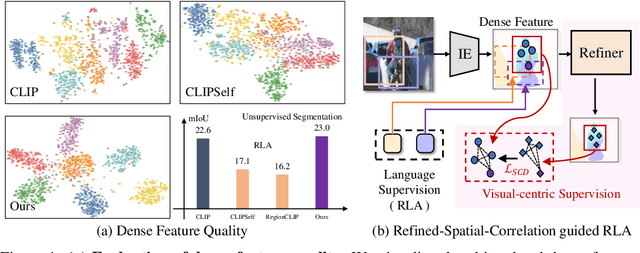
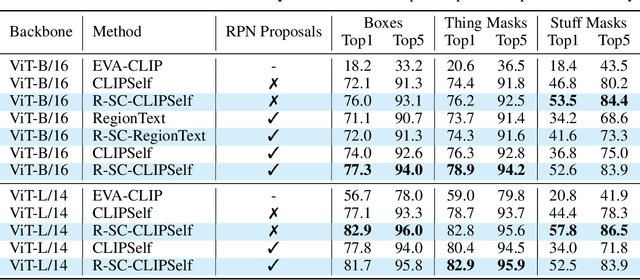


Abstract:Contrastive Language-Image Pre-training (CLIP) excels in global alignment with language but exhibits limited sensitivity to spatial information, leading to strong performance in zero-shot classification tasks but underperformance in tasks requiring precise spatial understanding. Recent approaches have introduced Region-Language Alignment (RLA) to enhance CLIP's performance in dense multimodal tasks by aligning regional visual representations with corresponding text inputs. However, we find that CLIP ViTs fine-tuned with RLA suffer from notable loss in spatial awareness, which is crucial for dense prediction tasks. To address this, we propose the Spatial Correlation Distillation (SCD) framework, which preserves CLIP's inherent spatial structure and mitigates the above degradation. To further enhance spatial correlations, we introduce a lightweight Refiner that extracts refined correlations directly from CLIP before feeding them into SCD, based on an intriguing finding that CLIP naturally captures high-quality dense features. Together, these components form a robust distillation framework that enables CLIP ViTs to integrate both visual-language and visual-centric improvements, achieving state-of-the-art results across various open-vocabulary dense prediction benchmarks.
Generating Multimodal Driving Scenes via Next-Scene Prediction
Mar 19, 2025Abstract:Generative models in Autonomous Driving (AD) enable diverse scene creation, yet existing methods fall short by only capturing a limited range of modalities, restricting the capability of generating controllable scenes for comprehensive evaluation of AD systems. In this paper, we introduce a multimodal generation framework that incorporates four major data modalities, including a novel addition of map modality. With tokenized modalities, our scene sequence generation framework autoregressively predicts each scene while managing computational demands through a two-stage approach. The Temporal AutoRegressive (TAR) component captures inter-frame dynamics for each modality while the Ordered AutoRegressive (OAR) component aligns modalities within each scene by sequentially predicting tokens in a fixed order. To maintain coherence between map and ego-action modalities, we introduce the Action-aware Map Alignment (AMA) module, which applies a transformation based on the ego-action to maintain coherence between these modalities. Our framework effectively generates complex, realistic driving scenes over extended sequences, ensuring multimodal consistency and offering fine-grained control over scene elements.
Towards Self-Improving Systematic Cognition for Next-Generation Foundation MLLMs
Mar 16, 2025Abstract:Despite their impressive capabilities, Multimodal Large Language Models (MLLMs) face challenges with fine-grained perception and complex reasoning. Prevalent pre-training approaches focus on enhancing perception by training on high-quality image captions due to the extremely high cost of collecting chain-of-thought (CoT) reasoning data for improving reasoning. While leveraging advanced MLLMs for caption generation enhances scalability, the outputs often lack comprehensiveness and accuracy. In this paper, we introduce Self-Improving Cognition (SIcog), a self-learning framework designed to construct next-generation foundation MLLMs by enhancing their systematic cognitive capabilities through multimodal pre-training with self-generated data. Specifically, we propose chain-of-description, an approach that improves an MLLM's systematic perception by enabling step-by-step visual understanding, ensuring greater comprehensiveness and accuracy. Additionally, we adopt a structured CoT reasoning technique to enable MLLMs to integrate in-depth multimodal reasoning. To construct a next-generation foundation MLLM with self-improved cognition, SIcog first equips an MLLM with systematic perception and reasoning abilities using minimal external annotations. The enhanced models then generate detailed captions and CoT reasoning data, which are further curated through self-consistency. This curated data is ultimately used to refine the MLLM during multimodal pre-training, facilitating next-generation foundation MLLM construction. Extensive experiments on both low- and high-resolution MLLMs across diverse benchmarks demonstrate that, with merely 213K self-generated pre-training samples, SIcog produces next-generation foundation MLLMs with significantly improved cognition, achieving benchmark-leading performance compared to prevalent pre-training approaches.
Monte Carlo Diffusion for Generalizable Learning-Based RANSAC
Mar 12, 2025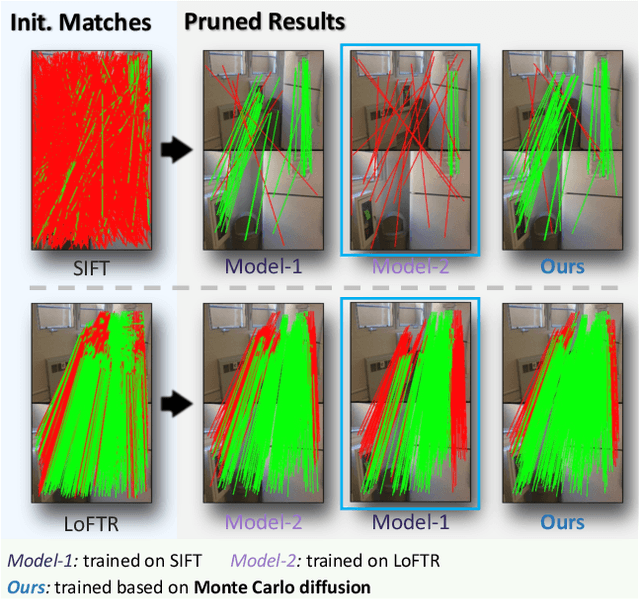

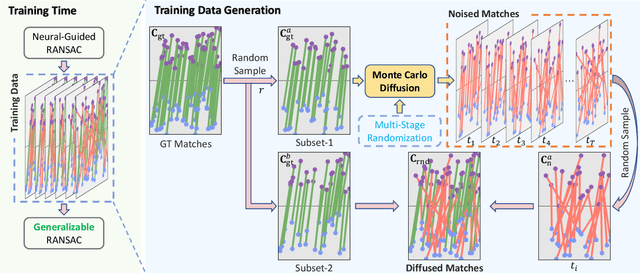

Abstract:Random Sample Consensus (RANSAC) is a fundamental approach for robustly estimating parametric models from noisy data. Existing learning-based RANSAC methods utilize deep learning to enhance the robustness of RANSAC against outliers. However, these approaches are trained and tested on the data generated by the same algorithms, leading to limited generalization to out-of-distribution data during inference. Therefore, in this paper, we introduce a novel diffusion-based paradigm that progressively injects noise into ground-truth data, simulating the noisy conditions for training learning-based RANSAC. To enhance data diversity, we incorporate Monte Carlo sampling into the diffusion paradigm, approximating diverse data distributions by introducing different types of randomness at multiple stages. We evaluate our approach in the context of feature matching through comprehensive experiments on the ScanNet and MegaDepth datasets. The experimental results demonstrate that our Monte Carlo diffusion mechanism significantly improves the generalization ability of learning-based RANSAC. We also develop extensive ablation studies that highlight the effectiveness of key components in our framework.
Coherent and Multi-modality Image Inpainting via Latent Space Optimization
Jul 10, 2024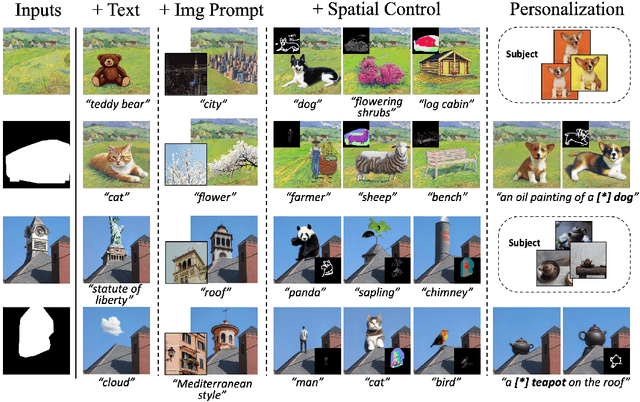

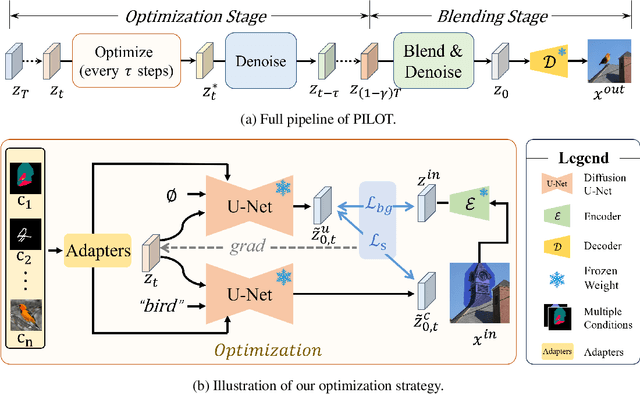
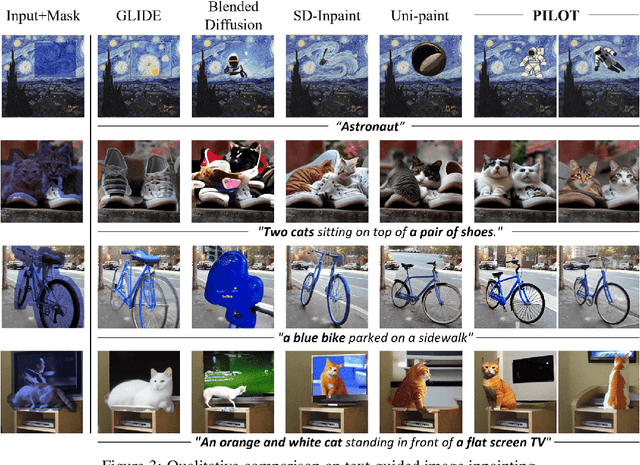
Abstract:With the advancements in denoising diffusion probabilistic models (DDPMs), image inpainting has significantly evolved from merely filling information based on nearby regions to generating content conditioned on various prompts such as text, exemplar images, and sketches. However, existing methods, such as model fine-tuning and simple concatenation of latent vectors, often result in generation failures due to overfitting and inconsistency between the inpainted region and the background. In this paper, we argue that the current large diffusion models are sufficiently powerful to generate realistic images without further tuning. Hence, we introduce PILOT (in\textbf{P}ainting v\textbf{I}a \textbf{L}atent \textbf{O}p\textbf{T}imization), an optimization approach grounded on a novel \textit{semantic centralization} and \textit{background preservation loss}. Our method searches latent spaces capable of generating inpainted regions that exhibit high fidelity to user-provided prompts while maintaining coherence with the background. Furthermore, we propose a strategy to balance optimization expense and image quality, significantly enhancing generation efficiency. Our method seamlessly integrates with any pre-trained model, including ControlNet and DreamBooth, making it suitable for deployment in multi-modal editing tools. Our qualitative and quantitative evaluations demonstrate that PILOT outperforms existing approaches by generating more coherent, diverse, and faithful inpainted regions in response to provided prompts.
Free Performance Gain from Mixing Multiple Partially Labeled Samples in Multi-label Image Classification
May 24, 2024

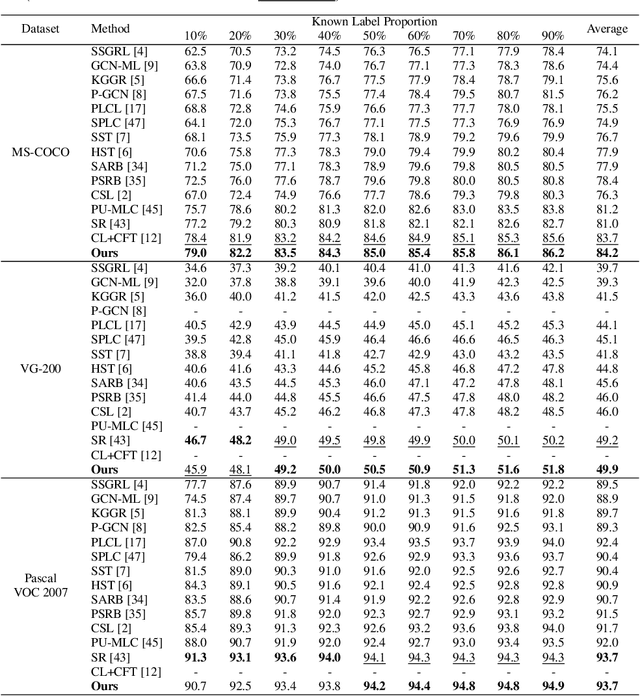
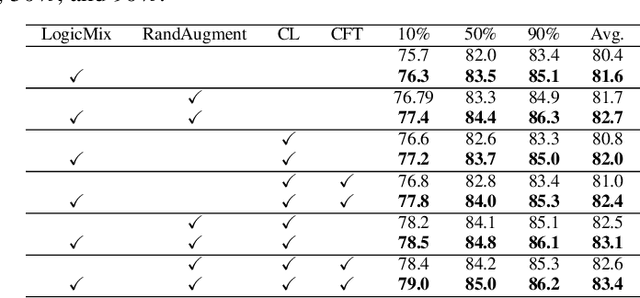
Abstract:Multi-label image classification datasets are often partially labeled where many labels are missing, posing a significant challenge to training accurate deep classifiers. However, the powerful Mixup sample-mixing data augmentation cannot be well utilized to address this challenge, as it cannot perform linear interpolation on the unknown labels to construct augmented samples. In this paper, we propose LogicMix, a Mixup variant designed for such partially labeled datasets. LogicMix mixes the sample labels by logical OR so that the unknown labels can be correctly mixed by utilizing OR's logical equivalences, including the domination and identity laws. Unlike Mixup, which mixes exactly two samples, LogicMix can mix multiple ($\geq2$) partially labeled samples, constructing visually more confused augmented samples to regularize training. LogicMix is more general and effective than other compared Mixup variants in the experiments on various partially labeled dataset scenarios. Moreover, it is plug-and-play and only requires minimal computation, hence it can be easily inserted into existing frameworks to collaborate with other methods to improve model performance with a negligible impact on training time, as demonstrated through extensive experiments. In particular, through the collaboration of LogicMix, RandAugment, Curriculum Labeling, and Category-wise Fine-Tuning, we attain state-of-the-art performance on MS-COCO, VG-200, and Pascal VOC 2007 benchmarking datasets. The remarkable generality, effectiveness, collaboration, and simplicity suggest that LogicMix promises to be a popular and vital data augmentation method.
Mitigating Object Dependencies: Improving Point Cloud Self-Supervised Learning through Object Exchange
Apr 11, 2024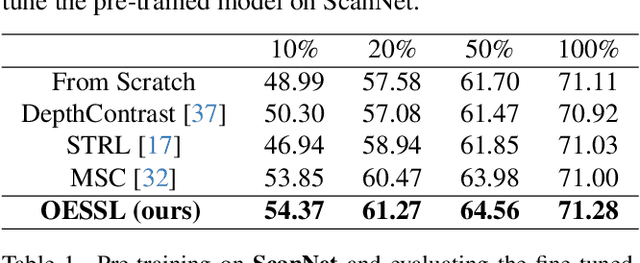
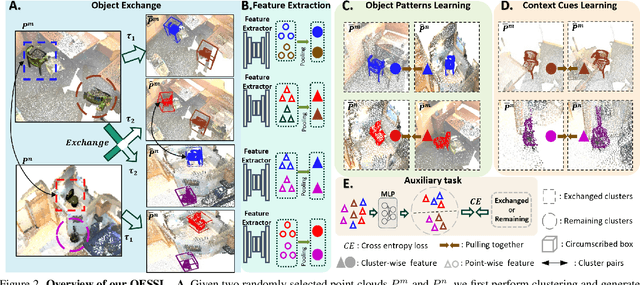

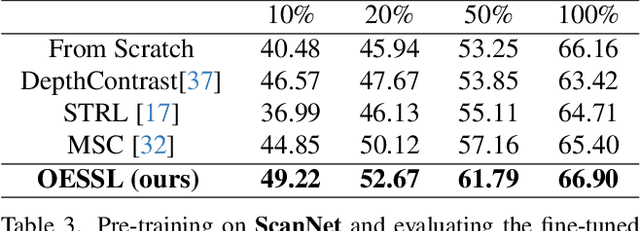
Abstract:In the realm of point cloud scene understanding, particularly in indoor scenes, objects are arranged following human habits, resulting in objects of certain semantics being closely positioned and displaying notable inter-object correlations. This can create a tendency for neural networks to exploit these strong dependencies, bypassing the individual object patterns. To address this challenge, we introduce a novel self-supervised learning (SSL) strategy. Our approach leverages both object patterns and contextual cues to produce robust features. It begins with the formulation of an object-exchanging strategy, where pairs of objects with comparable sizes are exchanged across different scenes, effectively disentangling the strong contextual dependencies. Subsequently, we introduce a context-aware feature learning strategy, which encodes object patterns without relying on their specific context by aggregating object features across various scenes. Our extensive experiments demonstrate the superiority of our method over existing SSL techniques, further showing its better robustness to environmental changes. Moreover, we showcase the applicability of our approach by transferring pre-trained models to diverse point cloud datasets.
 Add to Chrome
Add to Chrome Add to Firefox
Add to Firefox Add to Edge
Add to Edge